Tungsten.Chromium
Harmless

Posts: 41
Registered: 9-9-2014
Member Is Offline
Mood: No Mood
|
|
Need Help Separating different isomers of Halogenated Benzene Compounds
Hello all! Please move this to HW help is that is where it needs to be!
This will be my first semester in an organic chem/quantitative chemistry lab and we were told to come up with our own projects. Well after a few of
my ideas got shot down due to budget constraints, my group and I finally decided on Indigo/ThioIndigo and a few derivatives of them with
halogens/nitro-groups on the benzene rings.
We are going to be using the classic Baeyer-Drewson route that utilizes 2-Nitrobenzaldehyde and Acetone for Indigo. We are still browsing scifinder
to find a good mechanism for the ThioIndigo, but will most likely start from Thiophenol.
Now our TA told us to halogenate these starting reagents before we work towards synthesizing the final compound instead of trying to directly
halogenate the final products.
Now depending what position of the benzene ring the halogen (or other functional group) ends up on can effect the color of the finished dye. IE, 6,6'
dibromoindigo vs 5,5' dibromoindigo. I'm wondering how the pros would go about separating the different isomers. I was thinking maybe TLC, but am
not sure. Any input is appreciated. Oh and I'll be sure to keep this thread updated the best I can with the pretty colors we make!
Prosit!
|
|
|
unionised
International Hazard
    
Posts: 5102
Registered: 1-11-2003
Location: UK
Member Is Offline
Mood: No Mood
|
|
I'm fairly sure that both the aldehyde group and the nitro group are deactivating so halogenating it might be tough.
Having said that, halogenation of indigo isn't trivial.
I guess you considered this
https://pdfs.semanticscholar.org/23dd/576cef85c577d62bb1534a...
|
|
|
Cactuar
Harmless

Posts: 32
Registered: 25-7-2014
Location: Denmark
Member Is Offline
Mood: No Mood
|
|
It is possible with NBS in sulfuric acid (10.1080/00397911.2013.838790) but would give a horrendous mixture of mono and disubstituted isomers I don't
think will be easy to separate without a prep. HPLC. Seems most routes go by Sandmeyer reaction of an aniline to give the brominated arene.
|
|
|
Tungsten.Chromium
Harmless

Posts: 41
Registered: 9-9-2014
Member Is Offline
Mood: No Mood
|
|
Our TA let me know that the nitro group should be okay, but that we will need to use a protecting group for that can be easily removed after
halogenation. I don't have any experience with using protecting groups, so any ideas are welcome.
Quote: Originally posted by Cactuar  | | It is possible with NBS in sulfuric acid (10.1080/00397911.2013.838790) but would give a horrendous mixture of mono and disubstituted isomers I don't
think will be easy to separate without a prep. HPLC. Seems most routes go by Sandmeyer reaction of an aniline to give the brominated arene.
|
TA suggested using electrophoresis to seperate the different isomers and then cut the gel up? After a little reading, it looks like we should be able
to get the equipment from the Bio department. Making the gel should be fun though.
[Edited on 5-9-2019 by Tungsten.Chromium]
Prosit!
|
|
|
Cactuar
Harmless

Posts: 32
Registered: 25-7-2014
Location: Denmark
Member Is Offline
Mood: No Mood
|
|
I have never heard of nitro-group protection. Neither of using gel electrophoresis for anything other than DNA or proteins.
This is very interesting, I would like to hear what route you decide to use and its results!
|
|
|
Tungsten.Chromium
Harmless

Posts: 41
Registered: 9-9-2014
Member Is Offline
Mood: No Mood
|
|
To correct myself above*
Our TA let us know we would not need to worry about the nitro group, but was concerned the hydrogen of the aldehyde group would be halogenated before
the hydrogens on the benzene ring. According to your article though (https://www.tandfonline.com/doi/full/10.1080/00397911.2013.8...), we should be good to proceed without attaching a protecting group first.
I hadn't heard of using electrophoresis for separating isomers either, but the TA who specializes in extraction said it can be done 
The glassware care in last Tuesday and we should have the chemicals this week. Pictures should be coming in the next 7 days.
Prosit!
|
|
|
Metacelsus
International Hazard
    
Posts: 2531
Registered: 26-12-2012
Location: Boston, MA
Member Is Offline
Mood: Double, double, toil and trouble
|
|
Electrophoresis is an interesting idea. I know that different loading dyes migrate at different rates during DNA electrophoresis, so it might be
possible. Of course, you'll have to have some way of recovering the dye after you're done.
|
|
|
Tsjerk
International Hazard
    
Posts: 3022
Registered: 20-4-2005
Location: Netherlands
Member Is Offline
Mood: Mood
|
|
Strange story about that electrophoresis... Molecules have to be charged to be effected by an electric field. Wouldn't normal gravity column
chromatography be more sensible? But please correct me if I'm wrong.
Also the charge has to be different between the molecules to be able to seperate them..
[Edited on 10-9-2019 by Tsjerk]
|
|
|
Sigmatropic
Hazard to Others
  
Posts: 307
Registered: 29-1-2017
Member Is Offline
Mood: No Mood
|
|
I've prepared some 6-Chloro-umbelliferone-3-carboxylic acid by chlorination of 2,4-dihydroxybenzaldehyde and subsequent ring forming reaction.
Oxidation of the aldehyde was not a major issue. The isomers had significantly different retention times to be purified by regular column
chromatography, if there was carboxylic acid present that'd also be removed.
You've got a deactivating nitro group on there, where I had two activating hydroxys so chlorination may proceed differently. For purification I'd
stick to chromatography or if you have the time for it, develop a crystallization.
Electrophoresis for small molecules is only applied as capillary Electrophoresis but that is no where near preparative. And there still you need a
charged molecule, all the neutrals elute together due to electro osmotic flow.
|
|
|
Tungsten.Chromium
Harmless

Posts: 41
Registered: 9-9-2014
Member Is Offline
Mood: No Mood
|
|
Update.
The department changed around the schedule so this week we are doing "quant-in-a-day." Most likely GC-MS,LC-MS, NMR, Etc. training. Chemicals were
not ordered until Friday as some groups didn't get their lists in until then, so we still don't have the required mats here yet anyways.
I ran the idea of gravity column chromatography by the TA and he said we could do that route instead. He let me know it will be more work intensive,
but I don't mind.
The first thing we will be doing is making regular indigo dye and analyzing it with the LC-MS to get our feet wet. Once that is complete, we'll move
onto the bromination of the nitrobenzadehyde and attempt to seperate the different isomers. If that goes smoothly, we will try and use the same
indigo route with the same brominated nitrobenzaldehyde to made different halogenated indigos. Use UV-Vis to document the wavelengths and I'll post
it em here.
Then its onto the Chlorination and Nitration experiments. Gonna be a colorful semester if all goes well 
[Edited on 16-9-2019 by Tungsten.Chromium]
Prosit!
|
|
|
Tungsten.Chromium
Harmless

Posts: 41
Registered: 9-9-2014
Member Is Offline
Mood: No Mood
|
|
Update!
*EDIT 2 - Let it be known at all reactions for this project are carried out IN A HOOD!!!
We have all our chemicals and glassware in and have run a few rxns. Checkout below for some pics and procedures!
5.087g of 2-Nitrbenzaldehyde was added to a 250mL Erlenmeyer flask and dissolved in 50mL of acetone under stirring. The acetone dissolved the
nitrobenzaldehyde quickly without any temp change
50mL of DI water was added under stirring
25mL of 1.077M NaOH(aq) was added dropwise. This quickly turned the solution blue, and then to a deep purple. This was exothermic. The solution was
left to stir for 15 minutes after addition of all NaOH(aq).
After stirring, the flask was moved to an ice bath for about 15 minutes to precipitate out the desired Indigo.
After cooling, the mixture was vacuum filtered. The flask was washed with water a few times to get as much leftover indigo out.
Once the cake had pulled most of the liquid through, we removed it from the buchner funnel to let dry.
A small about of blue residue on the side of the funnel leads me to believe the purple cake is in fact the desired product in a high concentration.
After letting sit overnight to dry, yield was 2.1855g
  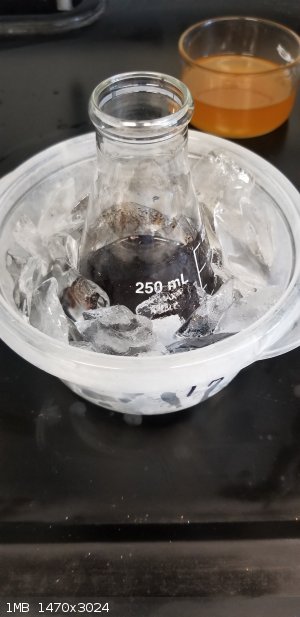 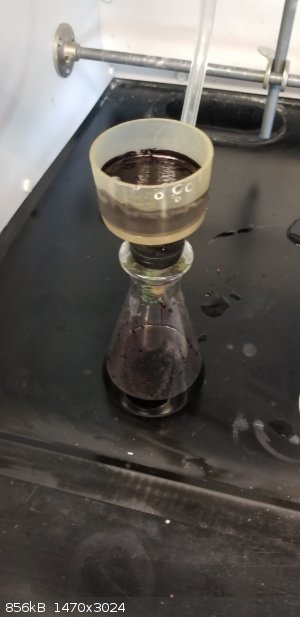 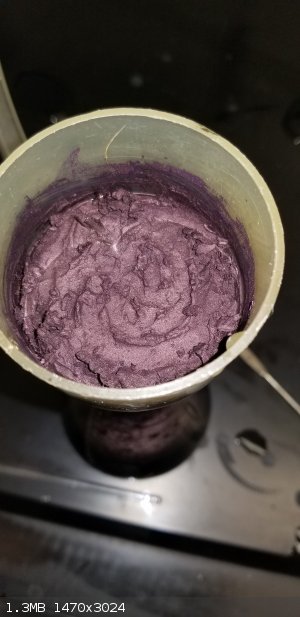 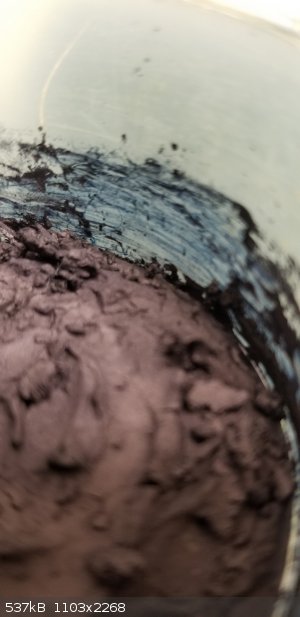
*EDIT
We are planning to prepare a solution 2.5mg indigo cake solution in 1mL chloroform-d in a day or two for NMR analysis. I will post the spectra once I
have it 
[Edited on 2-10-2019 by Tungsten.Chromium]
[Edited on 2-10-2019 by Tungsten.Chromium]
Prosit!
|
|
|
Tungsten.Chromium
Harmless

Posts: 41
Registered: 9-9-2014
Member Is Offline
Mood: No Mood
|
|
Bromination time!
16mL of concentrated H2SO4 was used to dissolve 2.499g of 2- nitrobenzaldehyde in a 250mL Erlenmeyer flask under stirring. Just like the acetone
previous nitrobenzaldehyde, it dissolved quick into a yellowish color.
We left that stirring for a while and went to weigh out 7.360g of n-bromosuccinimide(NBS) (1:2.5 molar ratio of NBS to NitroBenzaldehyde).
Upon adding the NBS to the flask, red fumes began to quickly form and evolve from the flask. As the fumes continued to get thicker and thicker by the
second, we decided to remove the flask from the stir plate. Which is when we noticed, it was hot. Since this reaction was not supposed to be
exothermic, my lab partners and I were confused.
Well, we touched the hot plate and realized that even though the indicator light was not illuminated, and the heat knob was turned off, the damn plate
was still producing heat. Lesson to be learned folks, always hold your hand on a hotplate for a few seconds after you plug it in to make sure its not
secretly heating your glassware.
AFTER swapping the plate for a good one that didn't heat without our permission, we let the reaction stir for 24 hours. The next day when we got to
the lab, we removed it and placed it in an ice bath, where it stayed over the weekend.
Upon returning to the lab today, three days later, we transfered the solution to a 125mL sep. funnel. Upon transfering it, two initial layers formed,
one was a dark brown/blackish layer(bottom) and the top was a lighter brown color. The layers combined upon agitation.
The solution was extracted with 3 x 25mL portions of ethyl acetate. After this, the three phases were combined and washed with saturated NaCl(aq).
This is where the project stands now. The next plan is to dry the solution with Na2SO4, followed by evaporation of the solvent in a rotovap.
Once we can get the compound by itself, it will be time for the moment we've all been dreading, separation of isomers...
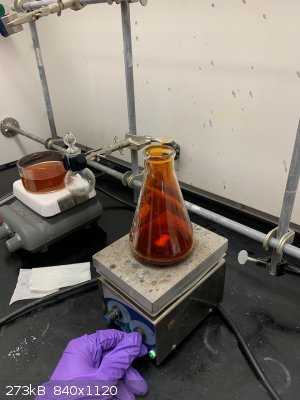  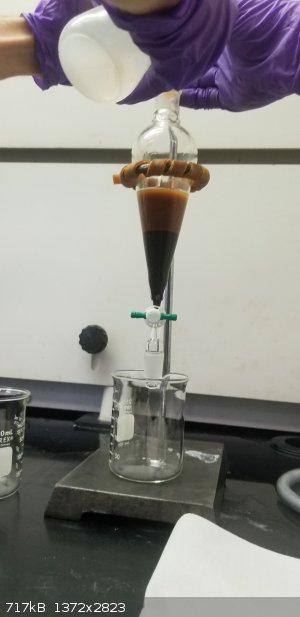 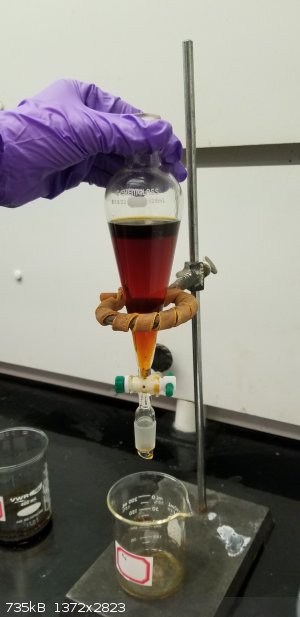 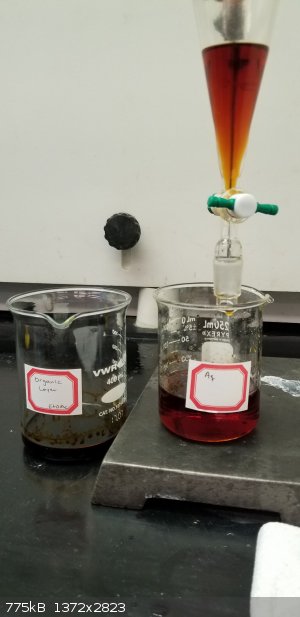
Prosit!
|
|
|
UC235
National Hazard
   
Posts: 565
Registered: 28-12-2014
Member Is Offline
Mood: No Mood
|
|
I've done this in total synthesis form from mononitration of p-toluidene in sulfuric acid, CuBr Sandmeyer reaction to 4-bromo-2-nitrotoluene,
CrO3/GAA/Ac2O benzylic oxidation to the benzaldiacetate (this reaction was trash and killed my yield), acid hydrolysis to 4-bromo-2-nitrobenzaldehyde
and finally a normal Baeyer-Drewson indigo synthesis.
Some of the intermediates were isolated and characterized. The nitrobromotoluene has a very high bp and took forever to come off GC but produces a
beautiful textbook mass spectra.
I found repeated acetone washes removed all sorts of reddish garbage from my indigo, both the normal baeyer drewson with off-the-shelf
2-nitrobenzaldehyde and my total synthesis product. The actual products are nigh-insoluble. I believe the side-product is indirubin and is probably
responsible for the purple indigo cake you made.
Here's my thoroughly acetone washed tyrian purple: https://i.imgur.com/Ls6FWPK.jpg
A solution of 6,6'-dibromoindigo is blue. The purple comes from the crystal packing which I can only really explain with handwaving.
I found a UV-Vis peak for blue synthetic and natural indigo at 618nm and 6,6-dibromoindigo at 608nm in DMSO. DMSO is the only solvent I found with
sufficient solubility to do this. It can't produce a concentrated enough solution for NMR though. The solubility of 6,6'-dibromoindigo is less than
0.4mg/ml. 0.02mg/ml was sufficiently colored for UV-Vis. Despite claims that it is soluble in chloroform, sonicating for hours gave me nothing.
You can also take a 1H-NMR spectra in D2O if you treat it with anhydrous sodium carbonate and sodium dithionite to produce the disodium salt of
6,6'-dibromoleucoindigo. You need to do this under nitrogen and covered with foil since it's reportedly photosensitive. You will only be able to see
the 3 aromatic protons, 2 doublets and a singlet overlapping one of the doublets.
https://i.imgur.com/uSP60cK.png
EDIT: I see you're still in-process with the halogenated derivatives. Are you following a paper? I would sort of expect a healthy amount of oxidation
vs ring bromination under those conditions, plus it sat out for a good while. Good luck!
[Edited on 2-10-2019 by UC235]
|
|
|
Tungsten.Chromium
Harmless

Posts: 41
Registered: 9-9-2014
Member Is Offline
Mood: No Mood
|
|
Quote: Originally posted by UC235  | I've done this in total synthesis form from mononitration of p-toluidene in sulfuric acid, CuBr Sandmeyer reaction to 4-bromo-2-nitrotoluene,
CrO3/GAA/Ac2O benzylic oxidation to the benzaldiacetate (this reaction was trash and killed my yield), acid hydrolysis to 4-bromo-2-nitrobenzaldehyde
and finally a normal Baeyer-Drewson indigo synthesis.
Some of the intermediates were isolated and characterized. The nitrobromotoluene has a very high bp and took forever to come off GC but produces a
beautiful textbook mass spectra.
I found repeated acetone washes removed all sorts of reddish garbage from my indigo, both the normal baeyer drewson with off-the-shelf
2-nitrobenzaldehyde and my total synthesis product. The actual products are nigh-insoluble. I believe the side-product is indirubin and is probably
responsible for the purple indigo cake you made.
Here's my thoroughly acetone washed tyrian purple: https://i.imgur.com/Ls6FWPK.jpg
A solution of 6,6'-dibromoindigo is blue. The purple comes from the crystal packing which I can only really explain with handwaving.
I found a UV-Vis peak for blue synthetic and natural indigo at 618nm and 6,6-dibromoindigo at 608nm in DMSO. DMSO is the only solvent I found with
sufficient solubility to do this. It can't produce a concentrated enough solution for NMR though. The solubility of 6,6'-dibromoindigo is less than
0.4mg/ml. 0.02mg/ml was sufficiently colored for UV-Vis. Despite claims that it is soluble in chloroform, sonicating for hours gave me nothing.
You can also take a 1H-NMR spectra in D2O if you treat it with anhydrous sodium carbonate and sodium dithionite to produce the disodium salt of
6,6'-dibromoleucoindigo. You need to do this under nitrogen and covered with foil since it's reportedly photosensitive. You will only be able to see
the 3 aromatic protons, 2 doublets and a singlet overlapping one of the doublets.
https://i.imgur.com/uSP60cK.png
EDIT: I see you're still in-process with the halogenated derivatives. Are you following a paper? I would sort of expect a healthy amount of oxidation
vs ring bromination under those conditions, plus it sat out for a good while. Good luck!
[Edited on 2-10-2019 by UC235] |
Wow! This information is extremely helpful! I hadn't even considered starting from p-toluidene, maybe next semester I can try that route if I stay
with this lab program.
We are currently following this (https://www.tandfonline.com/doi/full/10.1080/00397911.2013.8...) article to get brominated products. Last class, we dried the solution and
boiled off a good potion of the ethyl acetate. We then transferred it to an evaporating dish and are going to let it sit over the weekend in a hood.
Next Tuesday we will be attempting column chromatography to try and separate the different isomers. That is going to be the hardest part in the
whole synthesis.
We also attempted to run the indigo through NMR. We got water and acetone back, so the powder has been put in a schlenk flask to dry over the weekend
as well. Come Tuesday, I will suggest washing it with anhydrous acetone before trying NMR.
Your final product looks stunning by the way! We're hoping for something half as good, if we can separate the isomers that is.
Prosit!
|
|
|